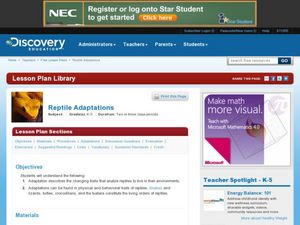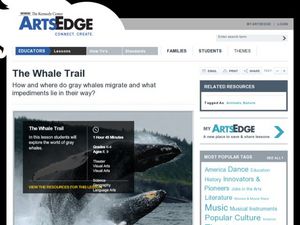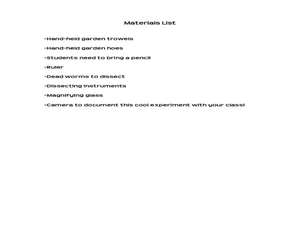Project Oceanography
Fish Shape
A fish's size, fins, and shape can tell us a lot about them! Learners explore fish anatomy to see how species use camouflage, scales, shape, and coloration to survive. The lesson includes advanced vocabulary such as fusiform shape,...
NOAA
Ocean Geologic Features
Sediment samples from the ocean bottoms tell scientists about climate change, pollution, and changes in erosion for the area. Groups of learners focus on sediments and their movement through water. During a hands-on activity, they...
Curated OER
The Mathematical Implications of Lying
Learners explore how statistics can be interpreted in different ways. In this probability lesson students complete a class lab activity then discuss their findings.
Virginia Department of Education
Planet Line-Ups
Should Pluto be considered a planet or a dwarf planet? Scholars research planets in our solar system to understand their similarities and differences. It also includes memory activities related to the order of the planets.
Curated OER
Make a Shadow Clock
Students create a shadow clock. In this time lesson, students make their own shadow clock or sundial from tag board. They place it on the ground and check it every hour to mark where the shadow lies.
Curated OER
Can Scientists Discover a Limit to Discovery?
Is there anything left to discover? Evaluate opposing sides of the debate regarding whether or not there is a future for scientific discovery. Middle and high schoolers assess quotations from the articles included to evaluate claims and...
Forest Foundation
The Nature of Trees
Young botanists examine the different parts of tress and then draw parallels between the functions of these parts and the function of parts of the human body.
Education World
Thinking About Thanksgiving: Lessons Across the Curriculum
Bring two integrated curriculum resources about Thanksgiving to an elementary social studies unit. The first activity focuses on Squanto's contributions to the early Pilgrims' survival with a gardening activity in which learners add fish...
Resources for Educators
Math & Science Connection
Whether you're using a collection of Dr. Seuss books to teach basic math skills like counting, adding, and subtracting, or exploring the different states of matter by melting a crayon with a hairdryer, a series of 11 fun activities...
It's About Time
Making Waves
Young scientists use Slinkys to better understand waves. After creating and measuring many aspects of waves, they complete a handout and homework questions. The resource also introduces the final project for the chapter, though it does...
DiscoverE
Kicking Machine
Don't kick the resource to the curb; you'll definitely regret it. Future engineers devise a kicking machine that launches a ping-pong ball toward a target. They can use a pendulum, a rubber band, or both, depending on whether they want...
Curated OER
Human Body: Pushing the Limits-Sensation
For this "Human Body: Pushing the Limits-Sensation" worksheet, learners watch the movie and respond to 25 fill in the blank and short answer questions regarding information from the documentary.
Curated OER
We're All Passenger
Students examine Passenger Pigeons and why they are now extinct. Through a class discussion, students discover the need to help endangered animals. They consider activities to become involved in assisting animals. Students write a poem...
Curated OER
Galileo's Thermometer: Measuring the Density of Various Unknown Liquids
Sprouting scientists explore the concept of density by making mass and volume measurements for five different liquids. From these measurements, they calculate densities. They apply their learning to explain Galileo's thermometer works...
Curated OER
In the Rain Shadow
Students, while utilizing a large wall map, experiment recording the annual precipitation for cities on the east and west sides of the Cascade Mountains. They discover that volcanic mountains do not have to erupt to affect the atmosphere.
Curated OER
Reptile Adaptations
Students research animal adaptations. In this adaptations lesson, students research the physical and behavioral adaptations of animals. Students create a diagram of their animal labeling it's adaptations.
Curated OER
Advertise Your Family
In this periodic table worksheet, students create an advertisement for a chemical group or family they are assigned. They need to include topics such as are the elements solids, liquids or gases at room temperature, the history of the...
Curated OER
Shark Attack
Students study the white shark and the red triangle. In this critical thinking lesson students assess the validity of facts about sharks and create a public service announcement either promoting shark or human protection.
Curated OER
The Whale Trail
Students research the Gray Whale. In this Gray Whale lesson, students use KWL charts to organize information. Students do Internet research to gain information about the whales. Students get into groups and create a mock news broadcast...
Curated OER
Astronomical Song Lyrics
In this astronomy and song lyrics worksheet, students are given 10 lyric fragments from different artists. Students select 3 of the fragments and write short essays about each to explain their thoughts from a human and astronomical point...
Curated OER
Parallel DC Circuits
In this circuits learning exercise, students answer 24 questions about parallel DC circuits including finding the current drawn by resistors, the total resistance, and the voltage impressed across each resistor in the circuit. Students...
Curated OER
A Science Trail: Worms
Third graders explore worms in multiple ways. In this lesson on worms, 3rd graders search for worms in their natural environment, record data on worms, and dissect worms.
Curated OER
Avalanche
Students investigate natural disasters by participating in an experiment. In this water formation lesson, students define the dangers associated with avalanches and landslides. Students utilize a bag of sand, meter-stick and a wood board...
Curated OER
Elements of Chemistry: Solids, Liquids and Gases
Young scholars predict if icebergs melting has an effect on the sea level rising. In this global warming lesson students complete an experiment to see the effects of melting icebergs and write a conclusion on their data collected.

























